Ancient Celtic religion
Ancient Celtic religion, commonly known as Celtic paganism,[1][2][3] comprises the religious beliefs and practices adhered to by the Iron Age people of Western Europe now known as the Celts, roughly between 500 BCE and 500 CE, spanning the La Tène period and the Roman era, and in the case of the Insular Celts the British and Irish Iron Age. Very little is known with any certainty about the subject, and apart from documented names that are thought to be of deities, the only detailed contemporary accounts are by hostile and probably not-well-informed Roman writers.
| Part of a series on |
| Celtic mythology |
|---|
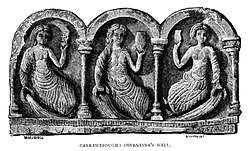 |
| Gaelic mythology |
| Brythonic mythology |
| Concepts |
| Religious vocations |
| Festivals |
|
Celtic paganism was one of a larger group of Iron Age polytheistic religions of the Indo-European family. It comprised a large degree of variation both geographically and chronologically, although "behind this variety, broad structural similarities can be detected"[4] allowing there to be "a basic religious homogeneity" among the Celtic peoples.[5]
The Celtic pantheon consists of numerous recorded theonyms, both from Greco-Roman ethnography and from epigraphy. Among the most prominent ones are Teutatis, Taranis and Lugus. Figures from medieval Irish mythology have also been interpreted as iterations of earlier pre-Christian Insular deities in the study of comparative mythology.
According to Greek and Roman accounts, in Gaul, Britain and Ireland, there was a priestly caste of "magico-religious specialists" known as the druids, although very little is definitely known about them.[6] Following the Roman Empire's conquest of Gaul (58–51 BCE) and southern Britannia (43 AD), Celtic religious practices began to display elements of Romanisation, resulting in a syncretic Gallo-Roman culture with its own religious traditions with its own large set of deities, such as Cernunnos, Artio, Telesphorus, etc.
In Roman Britain this lost at least some ground to Christianity by the time the Romans left in 410, and in the next century began to be replaced by the pagan Anglo-Saxon religion over much of the country. Christianity had resumed missionary activity by the later 5th and the 6th centuries, also in Ireland, and the Celtic population was gradually Christianized supplanting the earlier religious traditions. However, polytheistic traditions left a legacy in many of the Celtic nations, influenced later mythology, and served as the basis for a new religious movement, Celtic Neopaganism, in the 20th century.
Sources
Comparatively little is known about Celtic paganism because the evidence for it is fragmentary, due largely to the fact that the Celts who practiced it wrote nothing down about their religion.[7][8] Therefore, all there is to study their religion from is the literature from the early Christian period, commentaries from classical Greek and Roman scholars, and archaeological evidence.[9]
The archaeologist Barry Cunliffe summarised the sources for Celtic religion as "fertile chaos", borrowing the term from the Irish scholar Proinsias MacCana. Cunliffe went on to note that "there is more, varied, evidence for Celtic religion than for any other example of Celtic life. The only problem is to assemble it in a systematic form which does not too greatly oversimplify the intricate texture of its detail."[10]
Archaeological sources
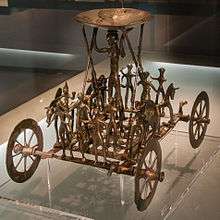
The archaeological evidence does not contain the bias inherent in the literary sources. Nonetheless, the interpretation of this evidence can be colored by the 21st century mindset.[7] Various archaeological discoveries have aided understanding of the religion of the Celts.
Most surviving Celtic art is not figurative; some art historians have suggested that the complex and compelling decorative motifs that characterize some periods have a religious significance, but the understanding of what that might be appears to be irretrievably lost. Surviving figurative monumental sculpture comes almost entirely from Romano-Celtic contexts, and broadly follows provincial Roman styles, though figures who are probably deities often wear torcs, and there may be inscriptions in Roman letters with what appear to be Romanized Celtic names. The Pillar of the Boatmen from Paris, with many deity figures, is the most comprehensive example, datable by a dedication to the Emperor Tiberius (r. from 14 AD).[11]
Monumental stone sculptures from before conquest by the Romans are much more rare, and it is far from clear that deities are represented. The most significant are the Warrior of Hirschlanden and "Glauberg Prince" (respectively 6th and 5th-century BCE, from Germany), the Mšecké Žehrovice Head (probably 2nd-century BCE, Czech Republic), and sanctuaries of some sort at the southern French oppida of Roquepertuse and Entremont. There are also a number of Celtiberian standing "warrior" figures, and several other stone heads from various areas. In general, even early monumental sculpture is found in areas with higher levels of contact with the classical world, through trade.[12] It is possible that wooden monumental sculpture was more common. Small heads are more common, mainly surviving as ornament in metalwork, and there are also animals and birds that may have a religious significance,[13] as on the Basse Yutz Flagons.[14] The Strettweg Cult Wagon is probably associated with libations or sacrifices, and pairs of metal "spoons" probably used for divination have been found.
Celtic coinage, from the late 4th century BCE until conquest, clearly copies Greek and Roman examples, sometimes very closely, but the heads and horses that are the most popular motifs may have a local religious significance.[15] There are also the coins of the Roman provinces in the Celtic lands of Gaul, Raetia, Noricum, and Britannia,
Most of the surviving monuments and their accompanying inscriptions belong to the Roman period and reflect a considerable degree of syncretism between Celtic and Roman gods; even where figures and motifs appear to derive from pre-Roman tradition, they are difficult to interpret in the absence of a preserved literature on mythology. A notable example of this is the horned god that was called Cernunnos; several depictions and inscriptions of him have been found, but very little is known about the myths that would have been associated with him or how he was worshipped.
Irish and Welsh records
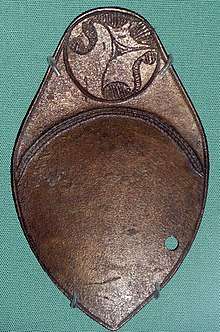
Literary evidence for Celtic religion also comes from sources written in Ireland and Wales during the Middle Ages, a period when traditional Celtic religious practices had become extinct and had long been replaced by Christianity. The evidence from Ireland has been recognised as better than that from Wales, being viewed as "both older and less contaminated from foreign material."[16] These sources, which are in the form of epic poems and tales, were written several centuries after Christianity became the dominant religion in these regions, and were written down by Christian monks, "who may not merely have been hostile to the earlier paganism but actually ignorant of it."[17] Instead of treating the characters as deities, they are allocated the roles of being historical heroes who sometimes have supernatural or superhuman powers, for instance, in the Irish sources the gods are claimed to be an ancient tribe of humans known as the Tuatha Dé Danann.
While it is possible to single out specific texts that can be strongly argued to encapsulate genuine echoes or resonances of the pre-Christian past, opinion is divided as to whether these texts contain substantive material derived from oral tradition as preserved by bards or whether they were the creation of the medieval monastic tradition.[7]
Greek and Roman records
Various Greek and Roman writers of the ancient world commented on the Celts and their beliefs. Barry Cunliffe stated that "the Greek and Roman texts provide a number of pertinent observations, but these are at best anecdotal, offered largely as a colourful background by writers whose prime intention was to communicate other messages."[10] The Roman general Julius Caesar, when leading the conquering armies of the Roman Republic against Celtic Gaul, made various descriptions of the inhabitants, though some of his claims, such as that the Druids practiced human sacrifice by burning people in wicker men, have come under scrutiny by modern scholars.
However, the key problem with the use of these sources is that they were often biased against the Celts, whom the classical peoples viewed as "barbarians".[7] In the case of the Romans who conquered several Celtic realms, they would have likely been biased in favour of making the Celts look uncivilised, thereby giving the "civilised" Romans more reason to conquer them.[18]
Deities
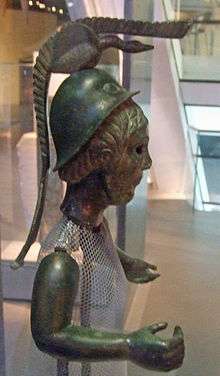
.jpg)
Celtic religion was polytheistic, believing in many deities, both gods and goddesses, some of which were venerated only in a small, local area, but others whose worship had a wider geographical distribution.[19] The names of over two hundred of these deities have survived to us today, although it is likely that many of these names were different titles or epithets used for the same deity.[4]
Common Celtic theonyms
Some Celtic theonyms can be established as Pan-Celtic (descending from the Common Celtic period) by comparing Continental with Insular Celtic evidence. An example of this is Gaulish Lugus, whose name is cognate with Irish Lugh and Welsh Lleu. Another example is Gaulish Brigantia, cognate with Irish Brigid. This latter theonym can even be reconstructed as a Proto-Indo-European epithet of the dawn goddess, as *bʰr̥ǵʰntī "the one on high".
Antiquity
Some of the Greek and Roman accounts mention various deities worshipped in Gaul; for instance Lucan noted the names of Teutates, Taranis and Esus,[20] although Julius Caesar instead conflated the Celtic Gaulish deities with those of Roman religion, and did not mention their native Gaulish names. He declared that the most widely venerated god in Gaul was Mercury, the Roman god of trade, but that they also worshipped Apollo, Minerva, Mars and Jupiter.[21]
According to other classical sources, the Celts worshiped the forces of nature and did not envisage deities in anthropomorphic terms,[22] as other "pagan" peoples such as the Greeks, Romans, and Egyptians did. Whether or not this is true, as the classical peoples grew in influence over the Celtic cultures, it encouraged the depiction of deities in human forms, and they appear to move from a more animistic-based faith to a more Romanised polytheistic view.
Several of these deities, including Lugus and Matrones, were triple deities.[23]
Insular mythology
In the Irish and Welsh vernacular sources from the Middle Ages, various human mythological figures were featured who have been thought of by many scholars as being based upon earlier gods. The historian Ronald Hutton however cautioned against automatically equating all Irish and Welsh mythological figures as former deities, noting that while some characters "who appear to be human, such as Medb or St Brigit, probably were indeed once regarded as divine ... the warriors who are the main protagonists of the stories have the same status as those in the Greek myths, standing between the human and divine orders. To regard characters such as Cú Chulainn, Fergus Mac Roich or Conall Cernach as former gods turned into humans by a later storyteller is to misunderstand their literary and religious function ... Cú Chulainn is no more a former god than Superman is."[24]
Examining these Irish myths, Barry Cunliffe stated that he believed they displayed "a dualism between the male tribal god and the female deity of the land"[25] while Anne Ross felt that they displayed that the gods were "on the whole intellectual, deeply versed in the native learning, poets and prophets, story-tellers and craftsmen, magicians, healers, warriors ... in short, equipped with every quality admired and desired by the Celtic peoples themselves."[26]
Insular Celts swore their oaths by their tribal gods, and the land, sea and sky; as in, "I swear by the gods by whom my people swear" and "If I break my oath, may the land open to swallow me, the sea rise to drown me, and the sky fall upon me."[27]
Animistic aspects
Some scholars, such as Prudence Jones and Nigel Pennick,[28] have speculated that the Celts venerated certain trees and others, such as Miranda Aldhouse-Green, that the Celts were animists, believing that all aspects of the natural world contained spirits, and that communication was possible with these spirits.[29]
Places such as rocks, streams, mountains, and trees may all have had shrines or offerings devoted to a deity residing there. These would have been local deities, known and worshiped by inhabitants living near to the shrine itself, and not pan-Celtic like some of the polytheistic gods. The importance of trees in Celtic religion may be shown by the fact that the very name of the Eburonian tribe contains a reference to the yew tree, and that names like Mac Cuilinn (son of holly) and Mac Ibar (son of yew) appear in Irish myths. In Ireland, wisdom was symbolised by the salmon who feed on the hazelnuts from the trees that surround the well of wisdom (Tobar Segais).
Burial and afterlife

Celtic burial practices, which included burying grave goods of food, weapons, and ornaments with the dead, suggest a belief in life after death.[30]
The druids, the Celtic learned classes that included members of the clergy, were said by Caesar to have believed in reincarnation and transmigration of the soul along with astronomy and the nature and power of the gods.[31]
A common factor in later mythologies from Christianized Celtic nations was the otherworld.[32] This was the realm of the fairy folk and other supernatural beings, who would entice humans into their realm. Sometimes this otherworld was claimed to exist underground, while at other times it was said to lie far to the west. Several scholars have suggested that the otherworld was the Celtic afterlife,[32] though there is no direct evidence to prove this.
Celtic practice
Evidence suggests that among the Celts, "offerings to the gods were made throughout the landscape – both the natural and the domestic."[34] At times they worshipped in constructed temples and shrines, evidence for which have been unearthed across the Celtic world by archaeologists, although according to Greco-Roman accounts, they also worshipped in areas of the natural world that were held to be sacred, namely in groves of trees. Across Celtic Europe, many of the constructed temples, which were square in shape and constructed out of wood, were found in rectangular ditched enclosures known as viereckschanzen, where in cases such as Holzhausen in Bavaria votive offerings were also buried in deep shafts.[35] However, in the British Isles, temples were more commonly circular in design. According to Barry Cunliffe, "the monumentality of the Irish religious sites sets them apart from their British and continental European counterparts" with the most notable examples being the Hill of Tara,[36] and Navan Fort.
However, according to Greco-Roman accounts of the druids and other Celts, worship was held in groves, with Tacitus describing how his men cut down "groves sacred to savage rites."[37] By their very nature, such groves would not survive in the archaeological record, and so we have no direct evidence for them today.[38] Alongside groves, certain springs were also viewed as sacred and used as places of worship in the Celtic world. Notable Gaulish examples include the sanctuary of Sequana at the source of the Seine in Burgundy and Chamalieres near to Clermont-Ferrand. At both of these sites, a large array of votive offerings have been uncovered, most of which are wooden carvings, although some of which are embossed pieces of metal.[39]
In many cases, when the Roman Empire took control of Celtic lands, earlier Iron Age sacred sites were reused, with Roman temples being built on the same sites. Examples include Uley in Gloucestershire, Worth in Kent, Hayling Island in Hampshire, Vendeuil-Caply in Oise, Saint-Germain-le-Rocheux in Chatillon-sur-Seine and Schleidweiler in Trier.[40]
Votive offerings
The Celts made votive offerings to their deities, which were buried in the earth or thrown into rivers or bogs. According to Barry Cunliffe, in most cases, deposits were placed in the same places on numerous occasions, indicating continual usage "over a period of time, perhaps on a seasonal basis or when a particular event, past or pending, demanded a propitiatory response."[41]
In particular, there was a trend to offer items associated with warfare in watery areas, evidence for which is found not only in the Celtic regions, but also in Late Bronze Age (and therefore pre-Celtic) societies and those outside of the Celtic area, namely Denmark. One of the most notable examples is the river Thames in southern England, where a number of items had been deposited, only to be discovered by archaeologists millennia later. Some of these, like the Battersea Shield, Wandsworth Shield and the Waterloo Helmet, would have been prestige goods that would have been labour-intensive to make and thereby probably expensive.[41] Another example is at Llyn Cerrig Bach in Anglesey, Wales, where offerings, primarily those related to battle, were thrown into the lake from a rocky outcrop in the late first century BCE or early first century CE.[41]
At times, jewellery and other high prestige items that were not related to warfare were also deposited in a ritual context. At Niederzier in the Rhineland for example, a post that excavators believed had religious significance had a bowl buried next to it in which was contained forty-five coins, two torcs and an armlet, all of which made out of gold, and similar deposits have been uncovered elsewhere in Celtic Europe.[42]
Human sacrifice
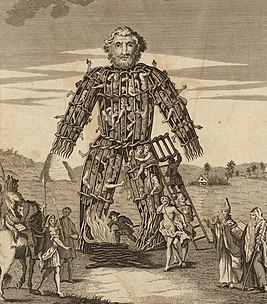
According to Roman sources, Celtic Druids engaged extensively in human sacrifice.[43] According to Julius Caesar, the slaves and dependents of Gauls of rank would be burnt along with the body of their master as part of his funerary rites.[44] He also describes how they built wicker figures that were filled with living humans and then burned.[45] According to Cassius Dio, Boudica's forces impaled Roman captives during her rebellion against the Roman occupation, to the accompaniment of revelry and sacrifices in the sacred groves of Andate.[46] Different gods reportedly required different kinds of sacrifices. Victims meant for Esus were hanged, Tollund Man being an example, those meant for Taranis immolated and those for Teutates drowned. Some, like the Lindow Man, may have gone to their deaths willingly.
Ritual decapitation was a major religious and cultural practice which has found copious support in the archaeological record, including the numerous skulls discovered in Londinium's River Walbrook and the 12 headless corpses at the French late Iron Age sanctuary of Gournay-sur-Aronde.[47]
Some Irish bog bodies from various periods are interpreted as local "kings" who were ritually executed, presumably after crop failures or other disasters. Old Croghan Man, from between 362 and 175 BCE, is an example, as is the far older Bronze Age Cashel Man.[48]
Head hunting
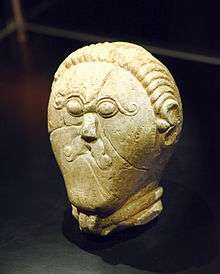
The iconography of the human head is believed by many archaeologists and historians to have played a significant part in Celtic religion. The Greek historian Diodorus Siculus, writing in the 1st century BCE, described how Celtic warriors "cut off the heads of enemies slain in battle and attach them to the necks of their horses."[49] Strabo meanwhile commented in the same century that until the Roman authorities put a stop to it, among the Celts, "the heads of enemies held in high repute they used to embalm in cedar oil and exhibit to strangers."[50] Archaeological evidence indicating that the Celts did indeed behead humans and then display their heads, possibly for religious purposes, has been unearthed at a number of excavations; one notable example of this was found at the Gaulish site of Entremont near to Aix-en-Provence, where a fragment of a pillar carved with images of skulls was found, within which were niches where actual human skulls were kept, nailed into position, fifteen examples of which were found.[51] Roquepertuse nearby has similar heads and skull niches; the Mšecké Žehrovice Head from the modern Czech Republic is a famous solitary stone head. On smaller decorated objects, heads often appear, or face-masks emerge from what may at first seem to be purely abstract patterning.
The archaeologist Barry Cunliffe believed that the Celts held "reverence for the power of the head" and that "to own and display a distinguished head was to retain and control the power of the dead person"[52] while the archaeologist Anne Ross asserted that "the Celts venerated the head as a symbol of divinity and the powers of the otherworld, and regarded it as the most important bodily member, the very seat of the soul."[53] The archaeologist Miranda Aldhouse-Green meanwhile stated that "I refute any suggestion that the head itself was worshipped but it was clearly venerated as the most significant element in a human or divine image representing the whole."[54] The historian Ronald Hutton however criticised the idea of the "cult of the human head", believing that both the literary and archaeological evidence did not warrant this conclusion, noting that "the frequency with which human heads appears upon Celtic metalwork proves nothing more than they were a favourite decorative motif, among several, and one just as popular among non-Celtic peoples."[55]
Priesthood
Druids
According to a number of Greco-Roman writers such as Julius Caesar,[56] Cicero,[57] Tacitus[58] and Pliny the Elder,[59] Gaulish and British society held a group of magico-religious specialists known as the druids in high esteem. Their roles and responsibilities differed somewhat between the different accounts, but Caesar's, which was the "fullest" and "earliest original text" to describe the druids,[60] described them as being concerned with "divine worship, the due performance of sacrifices, private or public, and the interpretation of ritual questions." He also claimed that they were responsible for officiating at human sacrifices, such as the wicker man burnings.[56] Nonetheless, a number of historians have criticised these accounts, believing them to be biased or inaccurate.[61][62] Vernacular Irish sources also referred to the druids, portraying them not only as priests but as sorcerers who had supernatural powers that they used for cursing and divination and who opposed the coming of Christianity.[63]
Various historians and archaeologists have interpreted the druids in different ways; Peter Berresford Ellis for instance believed them to be the equivalents of the Indian Brahmin caste,[64] while Anne Ross believed that they were essentially tribal priests, having more in common with the shamans of tribal societies than with the classical philosophers.[65] Ronald Hutton meanwhile held a particularly sceptical attitude to many claims made about them, and he supported the view that the evidence available was of such a suspicious nature that "we can know virtually nothing of certainty about the ancient Druids, so that – although they certainly existed – they function more or less as legendary figures."[66]
Poets
In Ireland the fili were visionary poets, which many get confused with Vates, associated with lorekeeping, versecraft, and the memorisation of vast numbers of poems. They were also magicians, as Irish magic is intrinsically connected to poetry, and the satire of a gifted poet was a serious curse upon the one being satirised. In Ireland a "bard" was considered a lesser grade of poet than a fili – more of a minstrel and rote reciter than an inspired artist with magical powers. In the Welsh tradition, the poet is always referred to as a "bardd".
The Celtic poets, of whatever grade, were composers of eulogy and satire, and a chief duty was that of composing and reciting verses on heroes and their deeds, and memorising the genealogies of their patrons. It was essential to their livelihood that they increase the fame of their patrons, via tales, poems and songs. In the 1st century CE, the Latin author Lucan referred to "bards" as the national poets or minstrels of Gaul and Britain. In Roman Gaul the institution gradually disappeared, whereas in Ireland and Wales it survived into the European Middle Ages. In Wales, the bardic order was revived, and codified by the poet and forger Iolo Morganwg; this tradition has persisted, centred around the many eisteddfods at every level of Welsh literary society.
Calendar
The oldest attested Celtic calendar is the Coligny calendar, dated to the 2nd century and as such firmly within the Gallo-Roman period.
Some feast days of the medieval Irish calendar have sometimes been speculated to descend from prehistoric festivals, especially by comparison to terms found in the Coligny calendar. This concerns Beltane in particular, which is attributed ancient origin by medieval Irish writers. The festivals of Samhain and Imbolc are not associated with "paganism" or druidry in Irish legend, but there have nevertheless been suggestions of a prehistoric background since the 19th century, in the case of Samhain by John Rhys and James Frazer who assumed that this festival marked the "Celtic new year".
Gallo-Roman religion

The Celtic peoples of Gaul and Hispania under Roman rule fused Roman religious forms and modes of worship with indigenous traditions. In some cases, Gaulish deity names were used as epithets for Roman deities, as with Lenus Mars or Jupiter Poeninus. In other cases, Roman gods were given Gaulish female partners – for example, Mercury was paired with Rosmerta and Sirona was partnered with Apollo. In at least one case – that of the equine goddess Epona – a native Celtic goddess was also adopted by Romans. This process of identifying Celtic deities with their Roman counterparts was known as Interpretatio romana.
Eastern mystery religions penetrated Gaul early on. These included the cults of Orpheus, Mithras, Cybele, and Isis. The imperial cult, centred primarily on the numen of Augustus, came to play a prominent role in public religion in Gaul, most dramatically at the pan-Gaulish ceremony venerating Rome and Augustus at the Condate Altar near Lugdunum on 1 August.
Generally Roman worship practices such as offerings of incense and animal sacrifice, dedicatory inscriptions, and naturalistic statuary depicting deities in anthropomorphic form were combined with specific Gaulish practices such as circumambulation around a temple. This gave rise to a characteristic Gallo-Roman fanum, identifiable in archaeology from its concentric shape.
Christianization
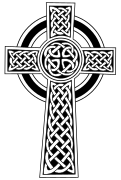
Celtic societies under Roman rule presumably underwent a gradual Christianization in similar ways to the rest of the Empire; there is next to nothing in Christian sources about specific issues relating to Celtic people in the Empire, or their religion. Saint Paul's Epistle to the Galatians was addressed to a congregation that might have included people from a Celtic background.
In Ireland, the main Celtic country unconquered by the Romans, the conversion to Christianity (Christianization) inevitably had a profound effect on the socio-religious system from the 5th century onward, though its character can only be extrapolated from documents of considerably later date. By the early 7th century the church had succeeded in relegating Irish druids to ignominious irrelevancy, while the filidh, masters of traditional learning, operated in easy harmony with their clerical counterparts, contriving at the same time to retain a considerable part of their pre-Christian tradition, social status, and privilege. But virtually all the vast corpus of early vernacular literature that has survived was written down in monastic scriptoria, and it is part of the task of modern scholarship to identify the relative roles of traditional continuity and ecclesiastical innovation as reflected in the written texts.
Cormac's Glossary (c. 900 CE) recounts that St. Patrick banished those mantic rites of the filidh that involved offerings to "demons", and that the church took particular pains to stamp out animal sacrifice and other rituals repugnant to Christian teaching. What survived of ancient ritual practice tended to be related to filidhecht, the traditional repertoire of the filidh, or to the central institution of sacral kingship. A good example is the pervasive and persistent concept of the hierogamy (sacred marriage) of the king with the goddess of sovereignty: the sexual union, or banais ríghi ("wedding of kingship"), which constituted the core of the royal inauguration, seems to have been purged from the ritual at an early date through ecclesiastical influence, but it remains at least implicit, and often quite explicit, for many centuries in the literary tradition.
Folkloristic survivals
Nagy has noted the Gaelic oral tradition has been remarkably conservative; the fact that we have tales in existence that were still being told in the 19th century in almost exactly the same form as they exist in ancient manuscripts leads to the strong probability that much of what the monks recorded was considerably older.[67] Though the Christian interpolations in some of these tales are very obvious, many of them read like afterthoughts or footnotes to the main body of the tales, which most likely preserve traditions far older than the manuscripts themselves.
Mythology based on (though, not identical to) the pre-Christian traditions was still common place knowledge in Celtic-speaking cultures in the 19th century. In the Celtic Revival, such survivals were collected and edited, thus becoming a literary tradition, which in turn influenced modern mainstream "Celticity".
Various rituals involving acts of pilgrimage to sites such as hills and sacred wells that are believed to have curative or otherwise beneficial properties are still performed. Based on evidence from the European continent, various figures that are still known in folklore in the Celtic countries up to today, or who take part in post-Christian mythology, are known to have also been worshiped in those areas that did not have records before Christianity.
In Twilight of the Celtic Gods (1996), Clarke and Roberts describe a number of particularly conservative folkloristic traditions in remote rural areas of Great Britain, including the Peak District and Yorkshire Dales, including claims of surviving pre-Christian Celtic traditions of veneration of stones, trees and bodies of water.[68]
Neopagan revival
Various Neopagan groups claim association with Celtic paganism. These groups range from the Reconstructionists, who work to practice ancient Celtic religion with as much accuracy as possible; to new age, eclectic groups who take some of their inspiration from Celtic mythology and iconography, the most notable of which is Neo-druidry.
References
- Ross, Anne (1974). Pagan Celtic Britain: Studies in Iconography and Tradition. London: Sphere Books Ltd.
- Hutton, Ronald (1991). The Pagan Religions of the Ancient British Isles: Their Nature and Legacy. Oxford, UK and Cambridge, USA: Blackwell.
- Jones, Prudence and Pennick, Nigel (1995). A History of Pagan Europe. Routledge.
- Cunliffe, Barry (1997). The Ancient Celts. Oxford and New York: Oxford University Press. p. 184.
- Ross, Anne (1986). The Pagan Celts. London: B.T. Batsford. p. 103.
- Hutton, Ronald (2009). Blood and Mistletoe: The History of the Druids in Britain. Yale University Press. p. 17.
- Miranda J. Green. (2005) Exploring the world of the druids. London: Thames & Hudson. ISBN 0-500-28571-3. p. 24.
- Emrys Evans (1992) Mythology Little Brown & Company. ISBN 0-316-84763-1. p. 170.
- Emrys Evans (1992) Mythology Little Brown & Company. ISBN 0-316-84763-1. pp. 170–171.
- Cunliffe, Barry (1997). The Ancient Celts. Oxford and New York: Oxford University Press. p. 183.
- Green (1989), Chapters 2 (female) and 4 (male).
- Stöllner, 119-125, 133
- Green (1989), Chapter 5, in particular pp. 142-144 on birds, pp. 146-149 on horse.
- Kaul, Fleming, pp. 106–110, "The not so ugly duckling: an essay on meaning" in: Gosden, Christopher, Crawford, Sally, Ulmschneider, Katharina, Celtic Art in Europe: Making Connections, 2014, Oxbow Books, ISBN 1782976582, 9781782976585, google books
- Green (1989), p. 140, 146-147, 149-150 (and see index)
- Hutton, Ronald (1991). The Pagan Religions of the Ancient British Isles: Their Nature and Legacy. Oxford, UK and Cambridge, USA: Blackwell. p. 147.
- Hutton, Ronald (1991). The Pagan Religions of the Ancient British Isles: Their Nature and Legacy. Oxford, UK and Cambridge, USA: Blackwell. p. 148.
- Dr Ray Dunning (1999) The Encyclopedia of World Mythology Parragon. ISBN 0-7525-8444-8.
- Cunliffe, Barry (1997). The Ancient Celts. Oxford and New York: Oxford University Press. p. 187.
- Lucan. Pharsalia.
- Caesar. Commentarii de Bello Gallico. Book 6.
- Juliette Wood. ‘Introduction.’ In Squire, C. (2000). The mythology of the British Islands: an introduction to Celtic myth, legend, poetry and romance. London & Ware: UCL & Wordsworth Editions Ltd. ISBN 1-84022-500-9. pp. 12–13.
- Emrys Evans — Little, Brown & Company, p. 171.
- Hutton, Ronald (1991). The Pagan Religions of the Ancient British Isles: Their Nature and Legacy. Oxford, UK and Cambridge, USA: Blackwell. pp. 175–176.
- Cunliffe, Barry (1997). The Ancient Celts. Oxford and New York: Oxford University Press. p. 185.
- Ross, Anne (1986). The Pagan Celts. London: B. T. Batsford. p. 102.
- Marie-Louise Sjoestedt, Gods and Heroes of the Celts, translated by Myles Dillon, Berkeley, CA, Turtle Island Foundation, 1982, p. 17. ISBN 0-913666-52-1.
- Jones, Prudence and Pennick, Nigel (1995). A History of Pagan Europe. Routledge. p. 81.
- Miranda Green. (1992:196) Animals in Celtic Life and Myth. London: Routledge. ISBN 0-415-05030-8.
- Barry Cunliffe, The Ancient Celts. Oxford, Oxford University Press, 1997, pp. 208–210. ISBN 0-19-815010-5.
- Julius Caesar, Commentarii de Bello Gallico 5:14 Archived 5 February 2016 at the Wayback Machine.
- The Celts in The Encyclopedia of World Mythology, Dr Ray Dunning, p. 91.
- Stöllner, 119-123
- Cunliffe, Barry (1997). The Ancient Celts. Oxford and New York: Oxford University Press. p. 197.
- Cunliffe, Barry (1997). The Ancient Celts. Oxford and New York: Oxford University Press. p. 200.
- Cunliffe, Barry (1997). The Ancient Celts. Oxford and New York: Oxford University Press. p. 207.
- Tacitus. Annales. XIV.
- Cunliffe, Barry (1997). The Ancient Celts. Oxford and New York: Oxford University Press. p. 198.
- Cunliffe, Barry (1997). The Ancient Celts. Oxford and New York: Oxford University Press. pp. 198–199.
- Cunliffe, Barry (1997). The Ancient Celts. Oxford and New York: Oxford University Press. p. 204.
- Cunliffe, Barry (1997). The Ancient Celts. Oxford and New York: Oxford University Press. p. 194.
- Cunliffe, Barry (1997). The Ancient Celts. Oxford and New York: Oxford University Press. p. 195.
- J. A. MacCulloch. "The Religion of the Ancient Celts - ch xvi, 1911". Retrieved 24 May 2007.
- Gaius Julius Caesar Commentaries on the Gallic War - Book VI:19, translated by W. A. McDevitte and W. S. Bohn, New York: Harper & Brothers, 1869.
- Gaius Julius Caesar Commentaries on the Gallic War - Book VI:16, translated by W. A. McDevitte and W. S. Bohn, New York: Harper & Brothers, 1869.
- '"Roman History", Cassius Dio, p. 95 ch. 62:7, Translation by Earnest Cary, Loeb classical Library". Retrieved 24 May 2007.
- French archaeologist Jean-Louis Brunaux has written extensively on human sacrifice and the sanctuaries of Belgic Gaul. See "Gallic Blood Rites," Archaeology 54 (March/April 2001), 54–57; Les sanctuaires celtiques et leurs rapports avec le monde mediterranéean, Actes de colloque de St-Riquier (8 au 11 novembre 1990) organisés par la Direction des Antiquités de Picardie et l'UMR 126 du CNRS (Paris: Éditions Errance, 1991); "La mort du guerrier celte. Essai d'histoire des mentalités," in Rites et espaces en pays celte et méditerranéen. Étude comparée à partir du sanctuaire d'Acy-Romance (Ardennes, France) (École française de Rome, 2000).
- Kingship and Sacrifice, National Museum of Ireland
- Diodorus Siculus. History. 5.29.
- Strabo. Geographica. IV.4.5.
- Cunliffe, Barry (1997). The Ancient Celts. Oxford, UK; New York, NY: Oxford University Press. p. 202.
- Cunliffe, Barry (1997). The Ancient Celts. Oxford, UK, New York, NY: Oxford University Press. p. 210.
- Ross, Anne (1974). Pagan Celtic Britain: Studies in iconography and tradition. London, UK: Sphere Books Ltd. pp. 161–162.
- Green, Miranda. The Gods of the Celts. p. 32.
- Hutton, Ronald (1991). The Pagan Religions of the Ancient British Isles: Their nature and legacy. Blackwell. p. 195.
- Caesar, Julius. De bello gallico. VI.13–18.
- Cicero. De divinatione. I.XVI.90.
- Tacitus. Annales. XIV.30.
- Pliny. Historiae naturalis. XVI.249.
- Hutton, Ronald (2009). Blood and Mistletoe: The History of the Druids in Britain. Yale University Press. p. 02.
- Piggott, Stuart (1968). The Druids. London: Thames & Hudson. p. 111.
- Hutton, Ronald (2009). Blood and Mistletoe: The History of the Druids in Britain. Yale University Press. pp. 04–05.
- Hutton, Ronald (2009). Blood and Mistletoe: The History of the Druids in Britain. Yale University Press. pp. 32–33.
- Ellis, Peter Berresford (1994). The Druids. London: Constable. passim.
- Ross, Anne (1967). Pagan Celtic Britain. London: Routledge. pp. 52–56.
- Hutton, Ronald (2007). The Druids London: Hambledon Continuum. p. xi.
- Nagy, Joseph Falaky (1985). The wisdom of the outlaw: the boyhood deeds of Finn in Gaelic narrative tradition. Berkeley: University of California Press. p. 2. ISBN 0-520-05284-6.
- David Clarke and Andy Roberts, Twilight of the Celtic Gods: An Exploration of Britain's Hidden Pagan Traditions (1996), ISBN 978-0-7137-2522-3; review.
- Green, Miranda (1989), Symbol and Image in Celtic Religious Art, Routledge, google books
- Stöllner, Thomas, "Between ruling ideology and ancestor worship: the mos maiorum of the Early Celtic Hero Graves", in: Gosden, Christopher, Crawford, Sally, Ulmschneider, Katharina, Celtic Art in Europe: Making Connections, 2014, Oxbow Books, ISBN 1782976582, 9781782976585, google books
Further reading
- Anwyl, Edward (1906), Celtic Religion in Pre-Christian Times.
- de Vries, Jan (1961) Keltische Religion, a comprehensive survey.
- Duval, Paul-Marie (1976) Les Dieux de la Gaule, new ed. updated and enlarged.
- Green, Miranda (1986, revised 2004) Gods of the Celts.
- Macbain, Alexander (1885), Celtic Mythology and Religion (Internet Archive online edition).
- Mac Cana, Proinsias (1970) Celtic Mythology, copious illustrations.
- MacCulloch, J. A. (1911) The Religion of the Ancient Celts (Project Gutenberg online edition; 2009 reprint: ISBN 978-1-60506-197-9).
- MacCulloch, J. A. (1948) The Celtic and Scandinavian Religions, Hutchinson's University Library (2005 reprint: Cosimo Classics, ISBN 978-1-59605-416-5).
- Maier, Bernhard (1997); originally published in German in 1994) Dictionary of Celtic religion and culture, Boydell & Brewer, ISBN 978-0-85115-660-6.
- Sjoestedt, Marie-Louise (1949, reissued 1982; originally published in French, 1940) Gods and Heroes of the Celts, comparisons between deities of the various Celtic cultures vs Classical models.
- Stercks, Claude (1986) Éléments de cosmogonie celtique, contains an interpretive essay on the goddess Epona and related deities.
- Vendryes, Joseph; Tonnelat, Ernest; Unbegaun, B.-O. (1948) Les Religions des Celtes, des Germains et des anciens Slaves.
External links
- Celtic folklore and mythology sacred-texts.com
